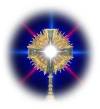
|
|
||||
 |
|
|||
Father John A. Hardon, S.J. Archives |
||||
Miracles Index |
||||
| |
||||
| Christ
the Miracle Worker in the Eucharist Fr. Hardon explains what a miracle is and tells us about the three levels of natural laws that God can surpass and thus perform a miracle: physical, moral and intellectual miracles. |
| How
the Miraculous Medal Changed My Life One of the most memorable experiences that I ever had was with the Miraculous Medal! ...This experience so changed my life that I have not been the same since. My faith in God, faith in His power to work miracles, was strengthened beyond description. |
| The Concept of Miracle from St. Augustine to Modern Apologetics It was not, however, until after the great persecutions, when peace was restored to the Church, that anything like a scientific examination was begun into the exact nature and function of miraculous phenomena. St. Augustine, in his controversy with the Manicheans, formulated the first theological definition of miraculum. Shortly after his conversion in 387, he wrote a treatise for his friend, Honoratus, still a Manichean, inviting him to accept the Christian faith. After pointing out the need for revelation, Augustine shows how reasonably the word of God may be embraced when fortified by miracles. He adds: "I call a miracle anything which appears arduous or unusual, beyond the expectation or ability of the one who marvels at it." |
| The Miracle Narratives in the Acts of the Apostles The following is a comprehensive schema of all the phenomena in the Acts which occurred after the Ascension and which are traditionally regarded as miraculous. Prophecies, visions, the gift of tongues and other spiritual graces are not included. Only physical miracles, in the technical sense of events which transcend the sensible forces of nature, are listed. |
| The Miracles of St. Francis Xavier December third of this year will mark the fourth centenary of the death of St. Francis Xavier. Among the glories of the saint which need to be vindicated at the present time are the miracles which four centuries of tradition have identified with his name. Rationalist criticism has consciously singled out the supernatural phenomena reported in the story of his life. The argument is that if you can eliminate divine intervention from the life of "one of the most noble and devoted men" in the history of the Church, you logically eliminate the same from the Church as a whole. Even Catholics have been influenced by this criticism. |
| Fatima and Miracles of Conversion Why…does God periodically communicate certain messages to the world, through such mystics as St. Francis of Assisi, St. Catherine of Siena and St. Theresa of Avila? He does this, not in order to reveal something unknown before, but to alert people to a revealed truth that had been ignored and that desperately needs to be met at certain periods of human history. |
| The Essential Message of Fatima On May 13, 1982, Pope John Paul II offered the Sacrifice of the Mass in Fatima, during his pilgrimage of gratitude to Portugal. During the Mass, the Pope preached a lengthy homily on "Mary’s Maternal Love." This homily I consider the most authoritative explanation of the meaning of Fatima that we have received from now seven Roman Pontiffs since the first revelations made at Fatima in 1917. |
| The Miracle of the Sun at Fatima The miracle of the sun at Fatima is more important than most people realize. It is, in fact, the divine confirmation of the message of Fatima. To appreciate its importance, we should ask ourselves three questions: What is a miracle? Why are miracles important? And how did the solar phenomenon at Fatima confirm the supernatural communication of Our Lady to the three children who were the immediate recipients of her communication? |
What's New Site Index
Home |
Directory |
Eucharist |
Divine Training |
Testimonials |
Visit Chapel |
Hardon Archives
Adorers Society | PEA Manual | Essentials of Faith | Dictionary | Thesaurus | Catalog | Newsletters
|